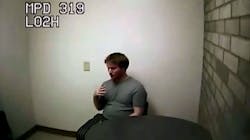How to Catch A Criminal: Accountable for Your Actions
Halloween night, 2011. Kathleen McGehee was attacked inside her bedroom in her Manteca, California home. She was repeatedly stabbed by an individual wearing a Halloween mask and died from her wounds. Kathleen’s terrifying final moments came shortly after a 4 p.m. phone call with her son, Colin. Kathleen was busy preparing food for a victim advocacy potluck and needed his advice on how to use her rice cooker. At 5 p.m., Kathleen did not answer a phone call from her daughter, Katelyn who had been out of town and planned be picked up by her mother. After the unusual missed call, Katelyn quickly received a call from her brother, 26-year-old Dawson. She told him she was trying to reach their mother about getting a ride. Dawson told Katelyn neither the home phone nor their mother’s cell phone had been working, and he wasn’t at home to ask her himself. After she tried calling her mother several more times, Dawson called again and offered to give her a ride himself.
The ride home with Dawson was peculiar to say the least. Rather than head straight home, Dawson said he needed to pick up some marijuana, which he called “his medicine.” He began driving toward Sacramento, about an hour away from Manteca, while also being chatty and more friendly than he normally was. He mentions their mother has been on a strict diet which has made her extra tired lately. At one point they stopped at a drugstore and Katelyn went inside to use the restroom. When she returned to the car, she found that Dawson wasn’t there. He had gone inside the store and was walking the aisles aimlessly. Next stop was for fast food, which they ate while driving around, lost for an hour. Dawson stated he normally makes this drive during the day and was having trouble finding his way in the dark. Dawson finally found the spot he was looking for, parking near a restaurant and telling Katelyn to wait there while he walked to his dealer’s place. He returned after 20 minutes, apparently worse for wear, stating he vomited on his walk. They finally headed back to Manteca, and arrived at the McGehee residence around 11 p.m.
The half-hour drive home had been stretched into a four-hour trek, and there was still no word from Kathleen. Once they were home, Dawson firmly told Katelyn their mother was asleep, as if she needed to be told not to bother a sleeping person in the middle of the night. Katelyn also noticed Dawson pacing the hallway throughout the night, seemingly guarding Kathleen’s bedroom. His behavior was a bit strange, but he wasn’t the most normal person on his best days.Dawson McGehee had been something of a black sheep in his family for quite some time. Prior to 2008, Dawson was an average mid-twenties male. Around that time however, his family began noticing changes in his demeanor. He became less social and unhappy. His treatment of Kathleen became rude and disrespectful. Mrs. McGehee had always been a caring individual, taking care of her brother who suffered from Parkinson’s Disease prior to his passing, and her sister who passed away from a brain tumor. After her siblings passed, she shifted her caretaker tendencies towards Dawson, giving him extra attention. It appears Dawson fed off of this attention, even developing shaking and stuttering symptoms similar to his late uncle’s Parkinson’s Disease, though Dawson’s symptoms would come and go. This of course garnered more love and care from his mother. Dawson also began exhibiting odd behaviors like walking around the house at night dressed in a Halloween mask. The masks became a fixation for Dawson, as well as watching horror movies. Dawson and one of his older brothers went to see a horror movie together earlier in 2011. Dawson got up to use the restroom but didn’t return to his seat. After some time his brother began looking around for him and found him seated in another part of the theater, alone and wearing a Halloween mask. As Dawson’s peculiar nature and mistreatment of his mother grew, Kathleen became less interested in putting up with him. She began volunteering at her church, helping with a victim advocacy program. She learned the importance of standing up for herself and not letting anyone, even her own son, push her around. On Halloween night, as she prepared for a meal for the victim advocacy potluck, she got in an argument with Dawson, and demanded he move out of the house. Kathleen was not going to take his attitude anymore and she wasn’t going to give him the attention he wanted. Dawson did not take this well.
On the morning of Nov. 1, Katelyn awoke and found Dawson was already awake. He informed her their mother got up between 5 and 6 a.m. but went back to bed because she didn’t sleep well. When Dawson wasn’t near, Katelyn tried to check on Kathleen but her bedroom door was locked, the shutters drawn, and she didn’t respond to knocks at her door. Dawson then took Katelyn to run an errand, carrying on his strange behavior from the previous night, driving to store locations further away from home than was necessary.
By 5 p.m., Katelyn was very worried for her mother and knocked louder and louder at the locked door. She eventually called 911 and first responders arrived and forced entry into the bedroom. Kathleen’s lifeless body was discovered in the room, stabbed 10 times in the neck and torso. Several of the stab wounds would have been fatal on their own. In hindsight, Dawson’s behavior clearly indicated he was hiding something and was buying time before anyone found his mother’s body. Dawson was arrested the following day while wearing a jacket stained with his mother’s blood. A bloody Halloween mask was also found inside the home When he was brought in for questioning, the strangeness increased.
Prior to interrogation, Dawson sat, waiting for a detective to enter the room. Little did he know, the camera in the interview room was already rolling. Dawson appeared to be completely normal, until he heard the door open. As soon as it did, Dawson’s Parkinson’s-esque symptoms returned in force. He stuttered and twitched, making seemingly involuntary movements, failing to answer questions as if he couldn’t comprehend them.
As the case was headed for trial, McGehee was evaluated by two psychologists. One expert psychologist evaluated him and determined he did not have a psychological disorder. Another psychologist assigned by the court did the same and found Dawson suffered from schizophrenia. He had been seen by psychologists in the past and complained of being attacked by demons and being visited by the Holy Spirit. Defense counsel argued McGehee was suffering from a hallucination in which a demon was attacking him, necessitating the use of deadly force in self defense. Unfortunately, the demon turned out to be his mother, but he did not know that at the time, and therefore could not be convicted of her murder due to his temporary insanity. The prosecution, however, asserted that while McGehee may have suffered from mental health issues, he showed consciousness of guilt when he deliberately misled his sister about his mother’s whereabouts and well-being. These statements indicated he knew what he had done and he was trying to hide it. A jury determined Dawson was sane at the time of the attack and found him guilty of Second Degree Murder. Dawson was sentenced to 15 years to life in prison.
Dawson being found sane at the time of the murder opens the door to several questions: Was he truly sane and using his mental illness as an excuse to get away with murder? Would a sane person do such a thing? Was it all an act from the start? Unfortunately, we will never know the answers to all of these questions. We do know, however, a man murdered his mother and was convicted of it, whether he meant to do it or not.
About the Author

Officer Brendan Rodela, Contributing Editor
Brendan Rodela is a Sergeant for the Lincoln County (NM) Sheriff's Office. He holds a degree in Criminal Justice and is a certified instructor with specialized training in Domestic Violence and Interactions with Persons with Mental Impairments.


